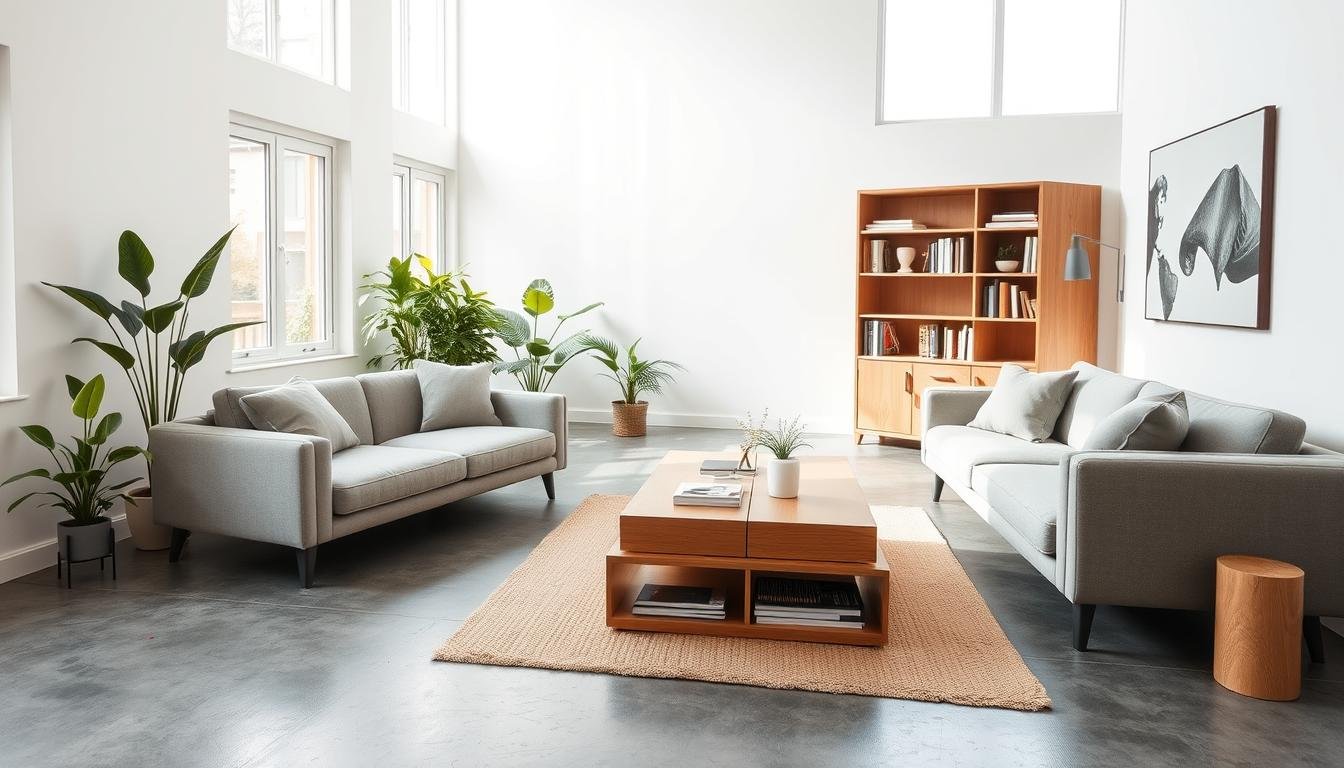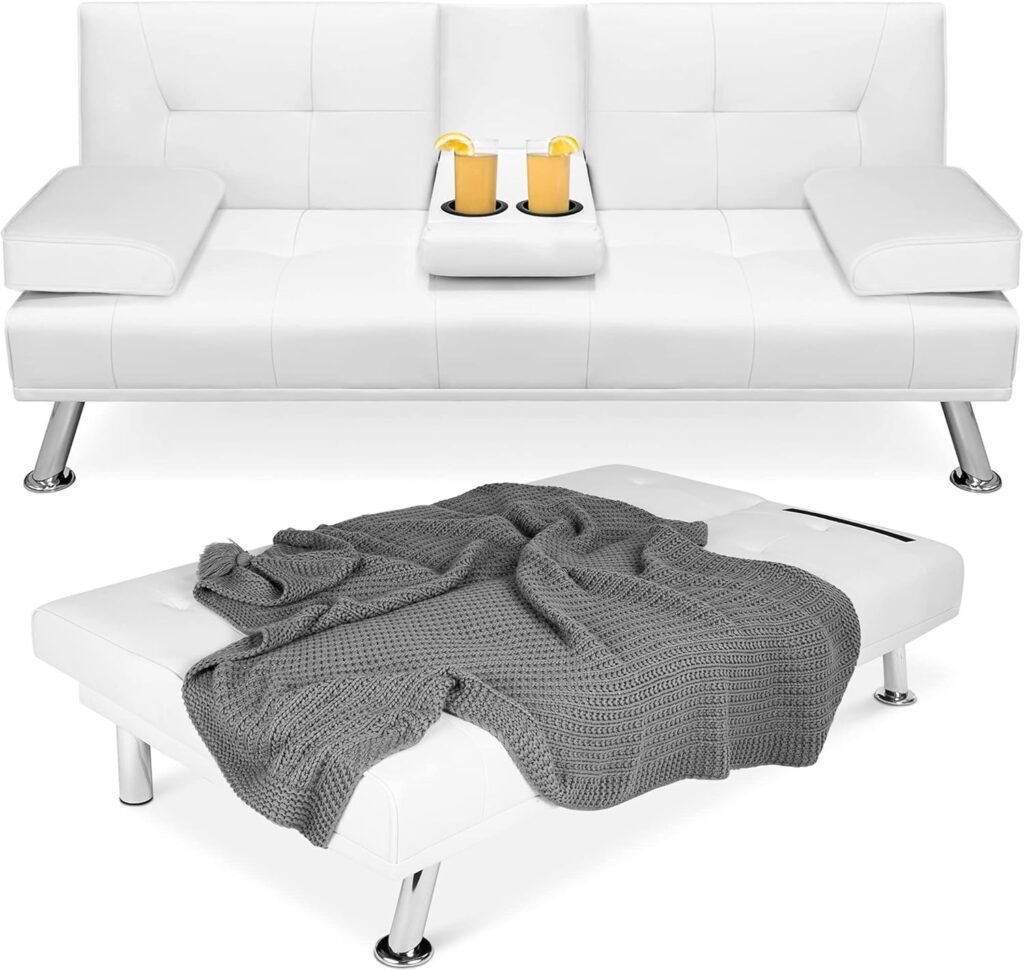Some links on this page are affiliate links. This means we may earn a commission at no additional cost to you if you click through and make a purchase. Thank you for your support!
In today’s world, the idea of a minimalist home is very appealing. Functional furniture for minimalist homes is key to achieving this balance, offering both style and practicality. But what makes furniture “functional” for such a space? How do you find the right mix of looks and usefulness to create a peaceful, clutter-free home? Let’s uncover the secrets to picking functional furniture for minimalist homes that enhances both aesthetics and the minimalist way of life.
Understanding Minimalist Home Philosophy
The minimalist home philosophy values simplicity, intention, and quality over quantity. It aims to create a clean, peaceful space. This lets homeowners enjoy the calm and function of a minimalist lifestyle.
Core Principles of Minimalism
- Simplicity: Minimalist homes avoid extra decorations, using clean lines and natural materials.
- Intentionality: Each item in a minimalist home has a purpose, improving the look or function.
- Quality over Quantity: Minimalists choose durable, high-quality items over many cheap ones.
Benefits of Minimalist Living
Living minimally can greatly improve your well-being. It reduces stress and makes cleaning easier. It also brings a calm and focused feeling.
Minimalist design supports mental health. It helps you stay present and focused. It can even help with anxiety and depression.
Impact on Mental Well-being
Minimalist spaces are calming. They use neutral colors, natural materials, and lots of light. This reduces distractions and promotes mindfulness.
By choosing their living space carefully, minimalist homeowners find peace. This peace affects all parts of their life.
Essential Characteristics of Minimalist Design
Minimalist design is all about clean lines and neutral colors. It focuses on what’s truly needed, not just what looks good. Each piece of furniture or decor has a purpose.
Minimalist homes are known for their open spaces and lots of natural light. They also have a balance between looks and function. The colors used are mostly whites, beiges, and grays, with a touch of color here and there.
Textiles like linen, wool, and cotton add warmth and comfort. They keep the minimalist look alive. The “Breathe” design trend makes spaces feel airy and elegant, perfect for relaxation.
Minimalist design started in the 20th century as a break from old, fancy styles. Designers like Dieter Rams believed in “less but better.” Their work has shaped this design philosophy.
| Minimalist Design Characteristics | Examples |
|---|---|
| Clean Lines | Furniture with simple, geometric shapes; unobtrusive lighting fixtures |
| Neutral Color Palettes | Whites, beiges, grays, and blacks with strategic use of accent colors |
| Functional Simplicity | Furniture and decor that serve a clear purpose without unnecessary ornamentation |
| Natural Materials | Wood, stone, glass, and other natural elements to create a warm, inviting atmosphere |
| Open Spaces | Uncluttered, well-lit rooms that promote a sense of freedom and relaxation |
By following minimalist design principles, homeowners can create beautiful and functional spaces. This design has proven to be timeless, inspiring many.
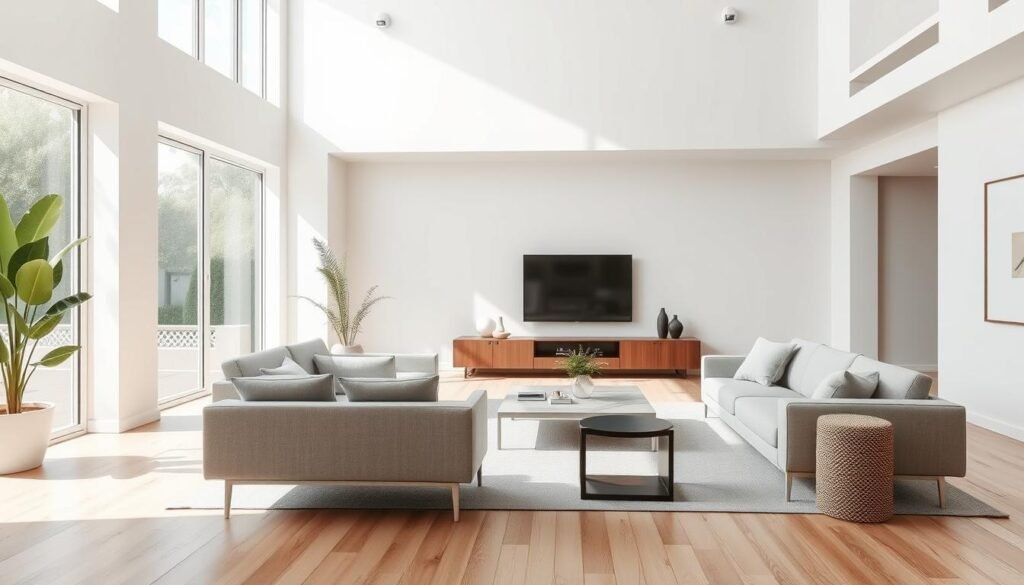
Functional Furniture for Minimalist Homes
In minimalist living, each piece of furniture must have a purpose. It should add to the simplicity of the home. Key features include space-saving, multi-purpose, and storage-integrated designs.
Space-saving Solutions
Minimalist furniture is known for its clean lines and curves. It focuses on simplicity with simple shapes. Items like foldable chairs and compact end tables save space, making rooms feel open and free from clutter.
Multi-purpose Furniture Ideas
Convertible sofas that transform into guest beds
convertible futon sofa offers 3 adjustable backrest positions, a fold-down armrest with cupholders, and a 500-pound weight capacity, making it perfect for lounging or overnight guests. Crafted from tufted faux leather with chrome legs, it combines style and durability. Compact and functional, it’s ideal for small spaces like apartments or dorms.
Dining tables that double as workstations
Ideal for minimalist homes, this foldable dining table seats 6-8 when extended and folds into a compact console. With drop-leaves, storage, and space for chairs (sold separately), it’s stylish, durable, and space-saving. Easy to clean and assemble.
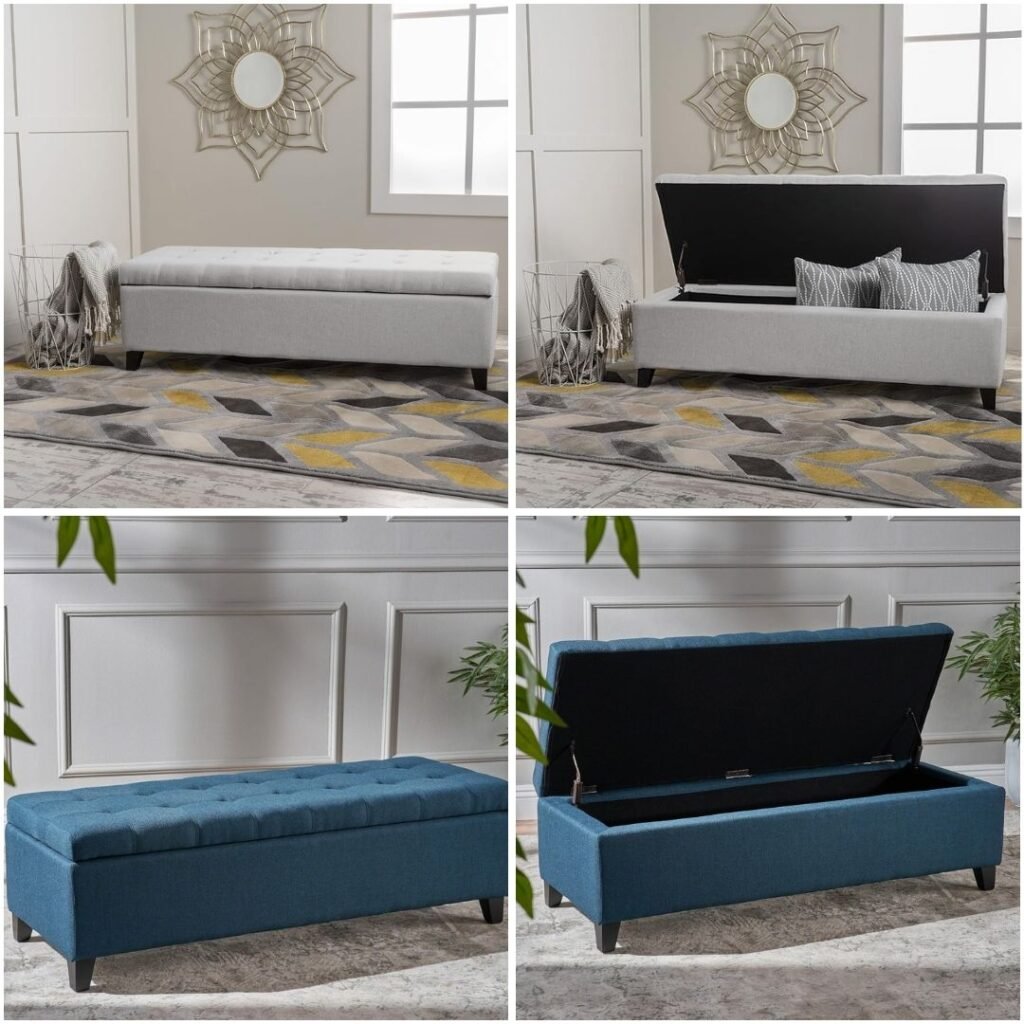
Storage ottomans with hidden compartments
This ottoman bench features a fabric seat, birch wood legs with a dark brown finish, and comes in multiple color options. Handcrafted with attention to detail, it requires assembly and supports up to 125 lbs.
Multifunctional furniture is a big part of minimalist design. Each piece does more than one thing, blending form and function perfectly.
Storage-integrated Pieces
Minimalist furniture often has built-in storage. Think beds with drawers or coffee tables with secret spots. These designs keep things tidy, keeping your home calm and clutter-free.
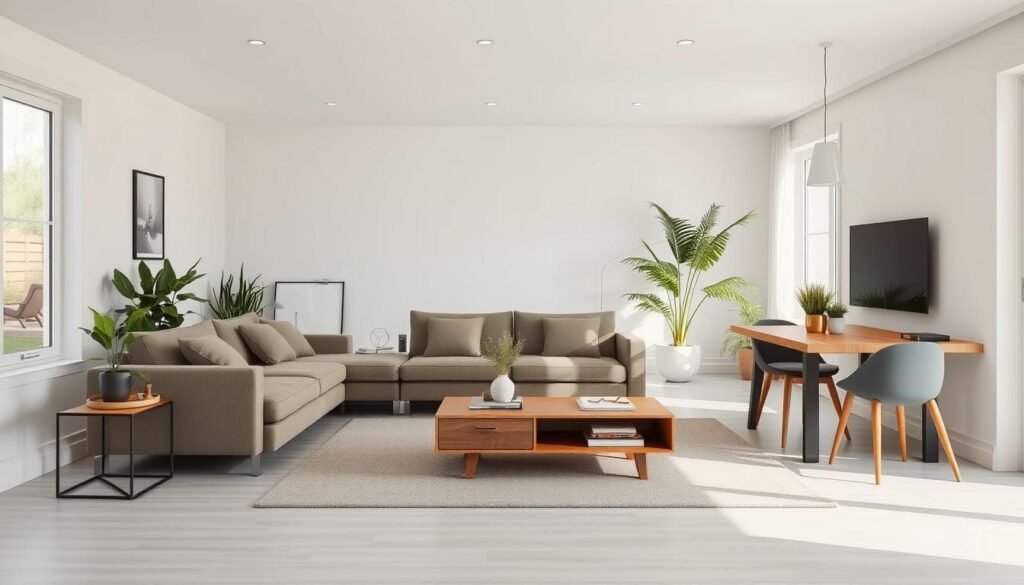
“Minimalist furniture contributes to space efficiency, creating an open, clutter-free environment that maximizes usable space, ideal for small rooms or apartments.”
Materials and Textures in Minimalist Furniture
In minimalist furniture, the choice of materials and textures is key. It often uses natural materials like wood, stone, and leather for warmth and texture. These elements connect us to nature and bring calm. They also contrast well with minimalist design’s clean lines.
Textures add depth and interest in minimalist spaces. Smooth surfaces, matte finishes, and subtle textures are popular. They make the space visually appealing yet calm. This invites people to enjoy the beauty of simplicity.
| Material | Texture | Benefits |
|---|---|---|
| Wood | Smooth, Organic Grain | Warmth, Durability, Natural Aesthetic |
| Stone (e.g., Marble, Granite) | Smooth, Polished | Luxurious, Timeless, Low-Maintenance |
| Leather | Soft, Supple | Tactile, Durable, Sophisticated |
| Linen, Cotton | Textured, Matte | Natural Fibers, Breathable, Casual |
Choosing the right minimalist furniture materials and textures makes a space beautiful and peaceful. This focus on detail makes the space calm and welcoming. It shows the beauty of minimalist living.
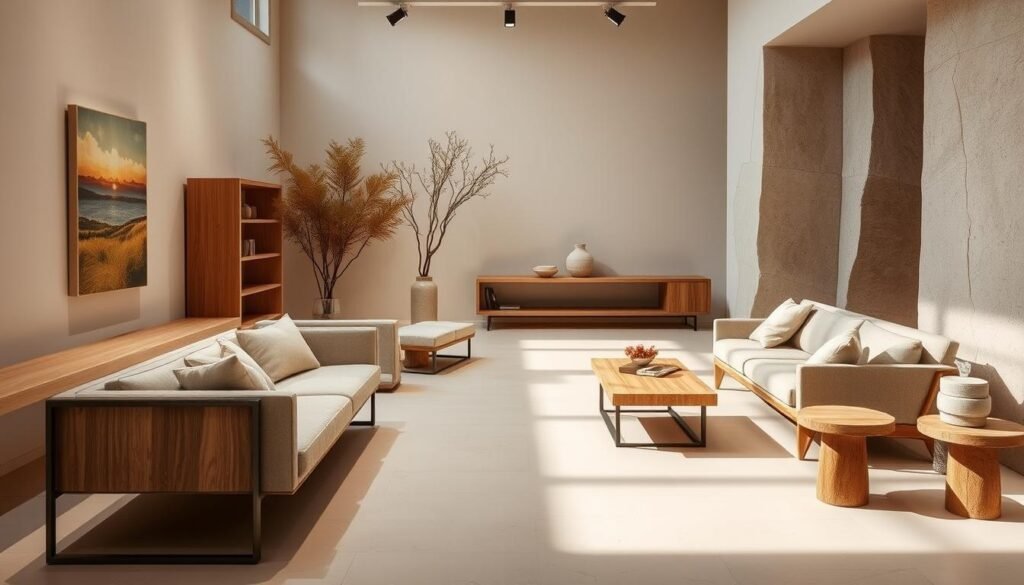
“The true essence of minimalist design lies in the thoughtful selection of materials and textures, which work together to create a serene and harmonious environment.”
Color Selection for Minimalist Spaces
Choosing colors is key in minimalist home design. Neutral colors like whites, grays, and earth tones are essential. They reflect light, making spaces feel larger and more open.
Neutral Color Palettes
Neutral colors, such as whites, beiges, and grays, are soothing. They help create a calm atmosphere. A single color scheme makes the space look seamless and harmonious.
Accent Colors and Their Use
Neutral colors are the base, but accent colors add personality. Soft blues, greens, or mustard yellows can be used in textiles or art. But, use them sparingly to keep the minimalist look intact.
Creating Visual Balance
Visual balance is crucial in minimalist design. It involves careful color use and contrasts. For example, a neutral sofa paired with a bold armchair adds interest without losing the minimalist vibe.
| Neutral Color Palettes | Accent Color Examples | Benefits of Visual Balance |
|---|---|---|
| Whites, grays, beiges, earth tones | Soft blues, greens, mustard yellows | Creates a harmonious, calming atmosphere; Enhances the clean, intentional aesthetic; Prevents the space from feeling stark or monotonous |
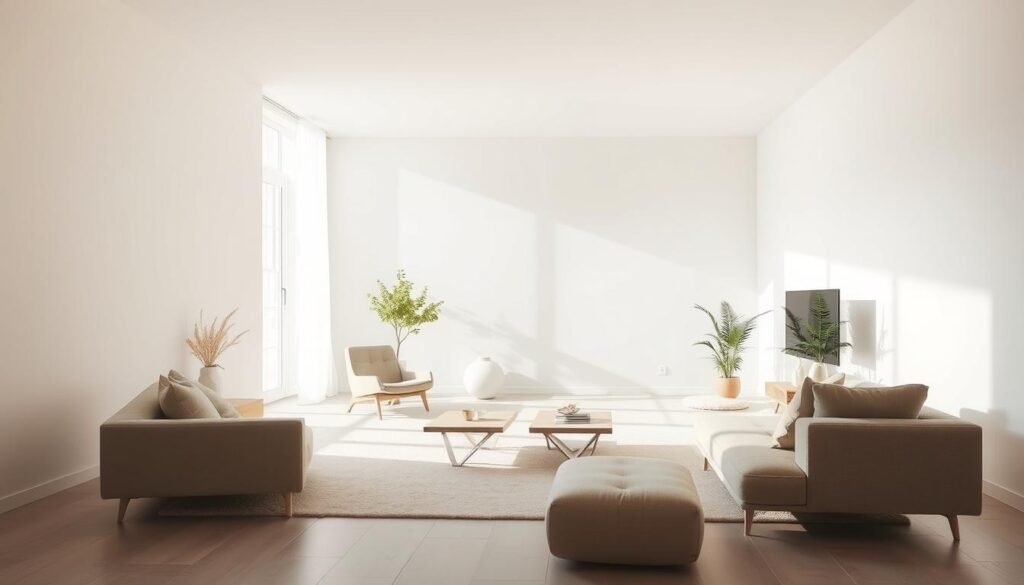
By picking neutral colors and adding accent hues wisely, minimalist design can create a balanced and peaceful space. This promotes tranquility and well-being.
Room-by-Room Furniture Selection Guide
Choosing the right furniture is key to a minimalist home. Each room, from living to office, needs essential pieces that do more than one thing. This guide will help you pick furniture that makes your space calm, organized, and beautiful.
Minimalist Living Room Furniture
Start with a sleek sofa as the room’s centerpiece. Add a slim coffee table and minimal storage like a side table or shelves. This keeps the room tidy. Neutral accent chairs add interest without cluttering the space.
Use natural light and lamps to enhance the minimalist look. This creates a clean, inviting atmosphere.
Minimalist Bedroom Furniture
In the bedroom, focus on a bed, dresser, and nightstand. Choose multi-purpose furniture, like a bed with storage, to save space. Mirrors make the room feel bigger.
Warm lighting and soft textiles in muted colors add coziness. This creates a peaceful, relaxing space.
Functional Dining Room Furniture
For the dining area, a minimalist table and chairs that match the style are essential. Choose furniture with clean lines and neutral colors. This keeps the minimalist feel alive.
Adding a sideboard or buffet for storage and display keeps the room uncluttered. This maintains the minimalist vibe.
Minimalist Office Furniture
In a minimalist office, focus on a functional desk, an ergonomic chair, and smart storage. Avoid too many items. Instead, pick furniture that blends technology and organization.
This setup helps you work efficiently without distractions. It keeps your office clutter-free and focused.
By choosing furniture that values simplicity and function, you can make your home’s rooms calm and organized. This promotes a sense of peace and order in every room.
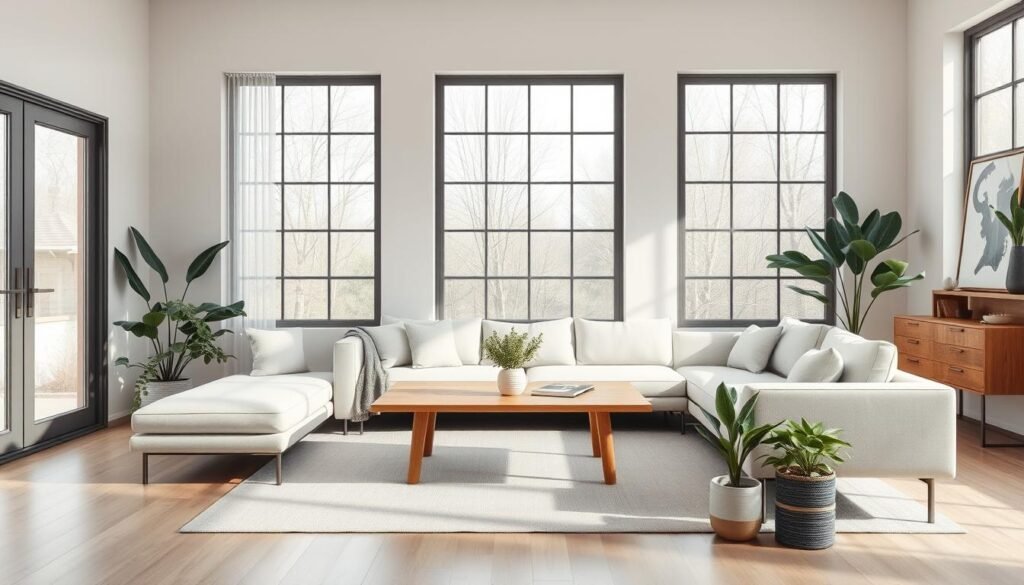
Space Planning and Layout Optimization
Creating a minimalist home means planning space well. This includes making sure paths are clear and furniture is placed smartly. By thinking about how people move, you can make rooms feel open and useful. Adding special pieces or art can make a room interesting without making it feel crowded.
Traffic Flow Considerations
When setting up your furniture, think about how people will move. Find the main paths and place furniture to keep them open. Make sure there’s enough room to walk and don’t block doors or busy areas. Also, think about how light and air move through the space.
Furniture Placement Tips
- Use furniture that does more than one thing, like ottomans with storage.
- Put big items like sofas and beds against walls to make rooms feel bigger.
- Place furniture to highlight special features or views.
- Try out uneven layouts to make spaces more interesting without losing function.
Creating Focal Points
In a minimalist space, a clear focal point can catch the eye and add depth. This could be a bold light, a piece of art, or a standout piece of furniture. By placing these points well, you can make your space both calm and visually appealing.
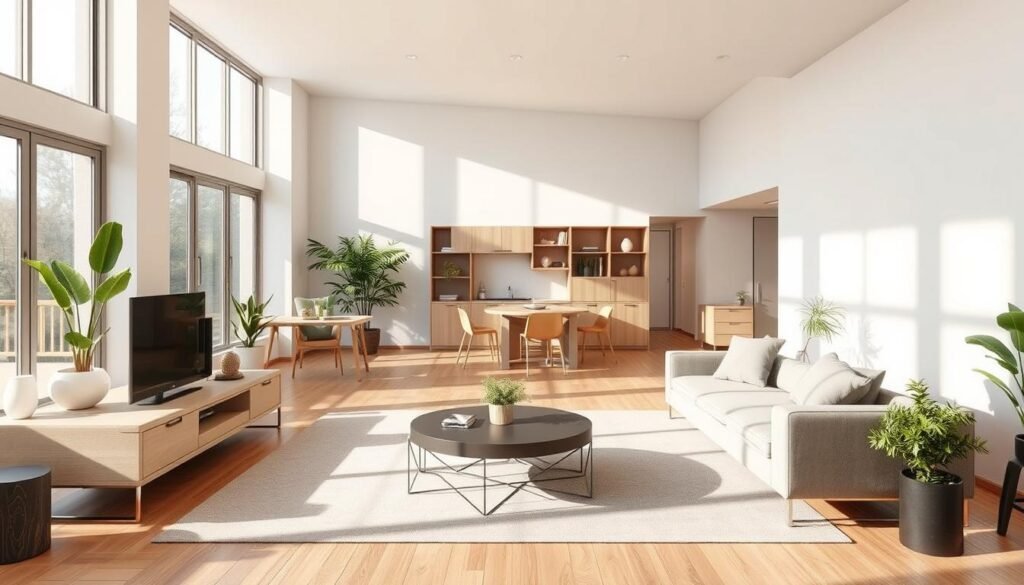
“The true essence of minimalism lies in the thoughtful arrangement of space, where every element serves a purpose and contributes to the overall sense of calm and balance.”
Quality vs Quantity: Making Smart Investments
In the world of minimalist design, quality is key. When furnishing your home, choose durable, well-made pieces. Look at material quality, construction, and versatility when picking quality minimalist furniture.
High-quality items might cost more upfront. But they last longer and look good forever. Surveys show 70% of people value functionality in furniture over looks for minimalist designs. This highlights the need for minimalist pieces that are useful.
In the last two years, demand for minimalist furniture has risen by 30%. People are now willing to spend 20% more on one quality piece than on several cheap ones. This shows a growing trend towards valuing quality over quantity. The market share of minimalist furniture has also grown by 5% each year for the past five years.
| Metric | Minimalist Furniture | Non-Minimalist Furniture |
|---|---|---|
| Return Rate | 8% | 15% |
| Sales Performance | 25% increase | N/A |
| Online Sales Growth | 40% increase | N/A |
| Sustainability Premium | 45% willing to pay | N/A |
For affordable minimalist furniture ideas, find a balance. Mix investment pieces with more affordable options. This way, you can create a beautiful, lasting minimalist space.
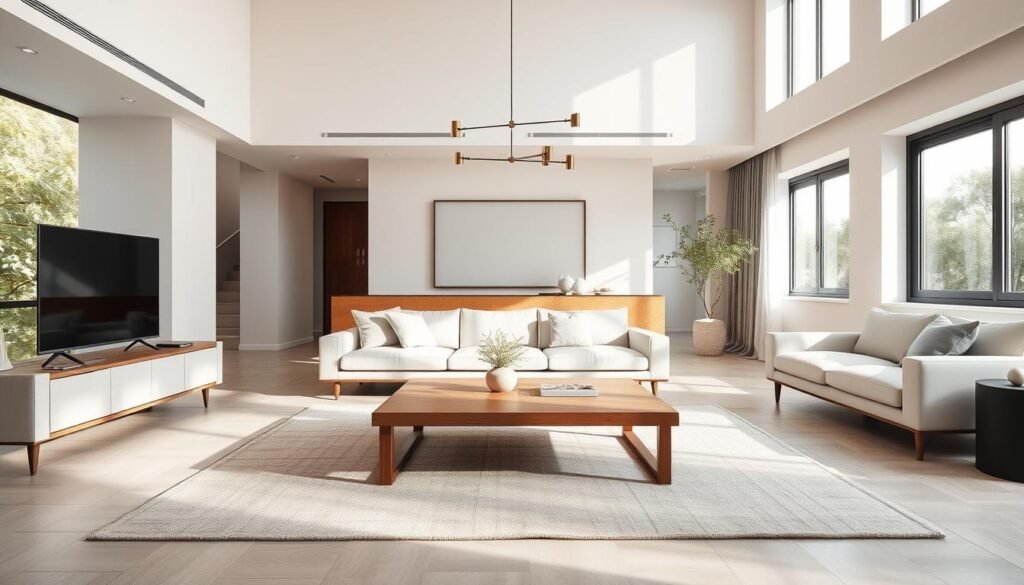
Choosing quality minimalist furniture is a smart move. It makes your home look better and lasts longer. By focusing on functionality, durability, and versatility, you’ll have a space that reflects your style and meets your needs.
Maintenance and Longevity of Minimalist Furniture
Keeping your minimalist furniture looking great is key to its lasting beauty. Regular cleaning and care extend its life. This ensures it stays a peaceful part of your home.
Cleaning and Care Tips
Start by dusting your furniture often with a soft, microfiber cloth. This keeps dirt and grime from building up. For deeper cleaning, use gentle cleaners that match the material, like wood, metal, or glass.
Act fast if you spill something on your furniture. Use a clean cloth to blot the spill. Then, apply a mild cleanser to remove the stain. Stay away from harsh chemicals and scrubbing to protect the finish.
Preserving Furniture Quality
Protect your furniture from sunlight and heat to prevent fading and damage. Place it away from windows and heaters. If needed, use UV-blocking window treatments.
Set up a maintenance routine to keep your furniture in top shape. This includes regular dusting, polishing, and fixing small issues. These steps help maintain your furniture’s clean look and quality craftsmanship.
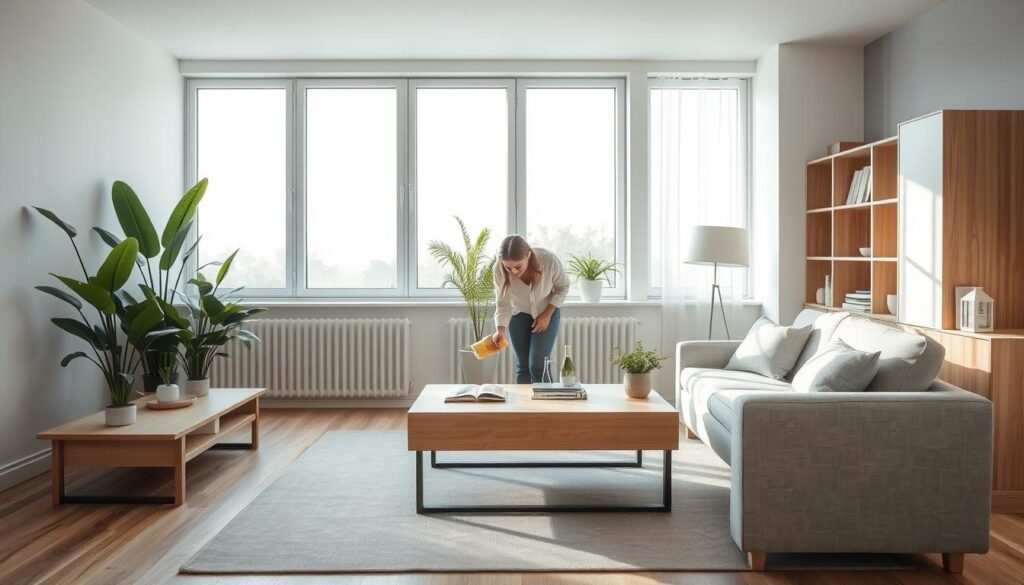
“Maintaining minimalist furniture is about striking a balance between simplicity and longevity. With thoughtful care, your investment pieces can continue to enhance the serene ambiance of your minimalist home for years to come.”
Sustainable and Eco-friendly Furniture Choices
As a minimalist, your furniture choices are key to an eco-friendly home. Choose furniture that’s good for the planet and fits your simple style. These picks not only cut down on waste but also bring natural beauty to your space.
Search for furniture from renewable or recycled materials, like reclaimed wood or recycled plastic. Look for FSC (Forest Stewardship Council) or GREENGUARD certifications. They mean the furniture is sourced responsibly and has low chemical emissions. Also, choose locally sourced furniture to cut down on emissions and support your community.
Buying durable, timeless pieces helps reduce waste and consumption. These sustainable furniture for minimalism items last long, so you won’t need to replace them often. Adding vintage or second-hand furniture brings unique charm and supports sustainability.
- Choose eco-friendly minimalist furniture made from renewable materials like bamboo and recycled metals.
- Look for furniture with certifications such as GOTS, OEKO-TEX, and Fair Trade to ensure ethical and sustainable practices.
- Support local artisans who create environmentally conscious minimalist design pieces.
- Consider the entire lifecycle of furniture, opting for items that can be easily recycled or degrade naturally at the end of their lifespan.
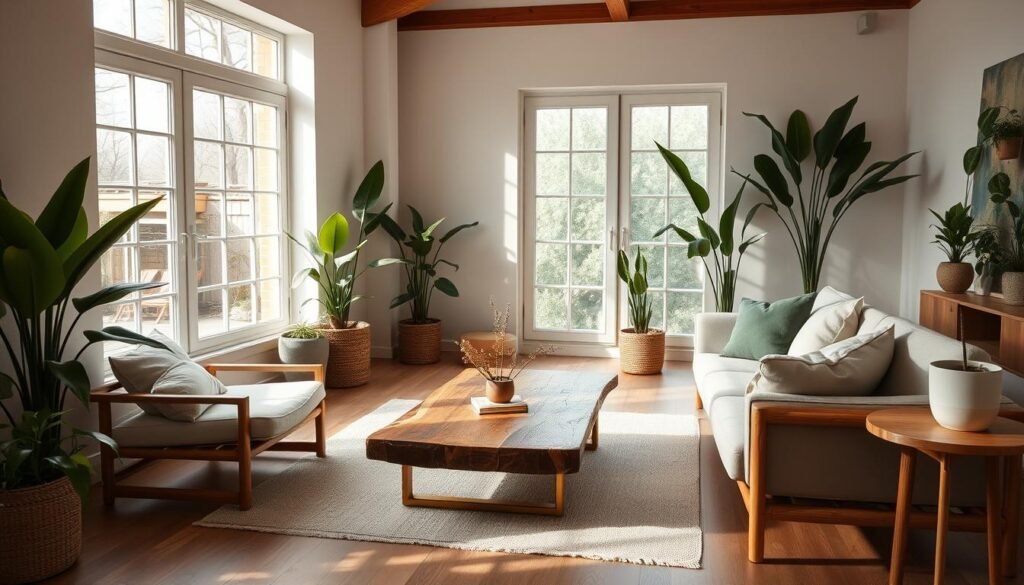
By picking sustainable furniture for minimalism wisely, you can make a home that’s both eco-friendly and reflects your values. It shows your dedication to taking care of the planet.
ALSO READ: How to Pick the Best Colors for Your Space
Conclusion
Choosing functional furniture for minimalist homes means finding a balance. It’s about simplicity, function, and looks. By understanding minimalist ideas, picking quality items, and using space wisely, you can make a calm and efficient home.
Focus on what’s really needed, choose sustainable options, and take care of your furniture. This way, your home stays organized, peaceful, and looks great. Living with minimalism makes your space better for your health and happiness.
The minimalist furniture tips and ideas in this article are a full guide. They help you pick furniture that’s both useful and looks good. By using multi-purpose items, natural materials, and simple colors, you can make a home that’s both beautiful and practical.
Investing in good, lasting, and eco-friendly furniture makes a minimalist home that’s not just pretty. It’s also healthier and more organized. The path of minimalist living is about being intentional, simple, and valuing the beauty in the basics. Follow these ideas, and turn your home into a peaceful and healthy space.
FAQ
What are the key characteristics of minimalist furniture?
Minimalist furniture is all about simplicity and function. It aims to remove clutter for a calm space. You’ll see clean lines, neutral colors, and natural materials. Plus, it’s designed to do more than one thing.
What are the core principles of minimalist home design?
Minimalist home design is about a clean, peaceful space. It’s simple, intentional, and values quality over quantity. Living this way can reduce stress and make cleaning easier.
How is minimalist design characterized?
Minimalist design is known for its clean look and focus on function. It uses minimal furniture and clear surfaces. Each piece is chosen for its purpose, not just to fill space.
What are some examples of functional furniture for minimalist homes?
In minimalist homes, furniture is chosen for its space-saving and versatility. Think foldable items and multi-use pieces like sofas that turn into beds. Furniture with built-in storage helps keep things tidy.
What materials and textures are commonly used in minimalist furniture?
Natural materials like wood, stone, and leather are popular in minimalist furniture. They add warmth and texture. These materials help create a calm, natural feel in the space.
How do you select the right colors for a minimalist space?
Choosing colors for minimalist spaces is all about calm and harmony. Stick to neutral colors like whites, grays, and earth tones. Use accent colors sparingly to add interest without cluttering the space.
What are the essential furniture pieces for different rooms in a minimalist home?
For each room, pick furniture that’s essential and multi-functional. Living rooms need a sofa, coffee table, and storage. Bedrooms have a bed, dresser, and nightstand. Dining rooms have a sleek table and chairs. Offices focus on a desk, chair, and smart storage.
How do you optimize space planning in a minimalist home?
Good space planning in minimalist homes means clear paths and smart furniture placement. Think about how people move through each room. Place furniture to keep space open and functional. Use statement pieces to add interest without clutter.
What should you consider when investing in minimalist furniture?
In minimalist design, quality is key. Choose durable, versatile pieces that last. While they might cost more upfront, they save money in the long run.
How do you maintain minimalist furniture?
Keeping minimalist furniture clean and well-maintained is important. Use gentle cleaners for each material. Dust and clean often to avoid buildup. Protect from sunlight and heat to prevent damage.
What are some sustainable and eco-friendly furniture options for minimalist homes?
Eco-friendly furniture fits well with minimalist values. Look for pieces made from renewable or recycled materials. Choose items with certifications like FSC or GREENGUARD. Opt for durable, timeless pieces to reduce waste.

